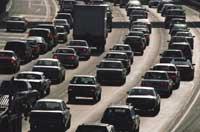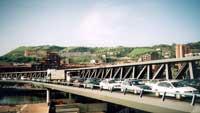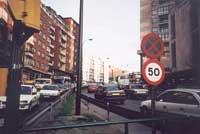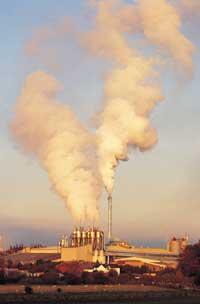You have dirty air Bilbao
At 7:30 in the morning, depending on the working hours, the driver left in the red light starts to get nervous. Today it is also late and nothing else turn on the green light sounds the horn and the engine launches at full speed. The driver could be the protagonist of a novel, but he is only one of the 350,000 employees who must enter or leave Gran Bilbao to go to work.

That's right, there are 350,000 cars that circulate daily in the Bilbao area, and to measure that great traffic and analyze the consequences concrete measurements are made. A wide network is currently being used, but since 1977, when the industry does not pose the problem of current air quality, the automatic monitoring and control network of air pollution of the Bajo Nervión-Ibaizabal is underway.
Today, in addition to the air quality, traffic is also measured through sensors managed by the Provincial Council of Bizkaia and the City of Bilbao. The sensors of the Provincial Council of Bizkaia narrate the cars that enter or leave the city daily, and the City of Bilbao, thanks to measurements in 140 significant points, offers two data of urban traffic: on the one hand, the percentage of the time of passage of vehicles on the road and on the other, the number of vehicles that pass through it every ten minutes.
High price of excessive traffic
Elena Agirre Basurko and Gabriel Ibarra Berastegi, researchers from the departments of Applied Mathematics and Fluid Mechanics of the UPV-EHU, have been evaluating since 1993 the air pollution caused by excessive traffic in the Greater Bilbao. According to his data, without fear of being mistaken, it can be said that Bilbao has great problems of air quality.

According to researchers Elena Agirre Basurko and Gabriel Ibarra Berastegi, "currently the main responsible for air pollution in Bilbao are ozone (O 3), nitrogen oxides (NOx) and carbon monoxide (CO) generated by traffic. Previously, the origin of air quality problems was OS 2 from industrial activity, while now the main problem is photo-chemical smog produced by urban traffic."
Smoga, or smoke mist, is a heavy, dark, domed fog that forms air pollution over large cities. The researchers point out that ozone is a special case, "ozone is a secondary pollutant, that is, it is not emitted directly into the atmosphere. It occurs when nitrogen oxides and volatile organic compounds react under solar radiation. The speed of ozone formation is conditioned by the concentrations of meteorological agents and antecedents, which are mainly due to traffic."
As for the extent of pollution, it can be said that air pollution is widespread in Gran Bilbao. In fact, Gran Bilbao is an atmospheric basin. Air mixes and pollution problems are similar in both places. Therefore, researchers believe that contaminants emitted in one place can affect anywhere in Greater Bilbao.
For example, thermal plants to be built in Zierbena (Bay of Biscay, 800 MW), Alonsotegi (Zabalgarbi, 95 MW) and Las Carreras (IGCC- Petronor, 800 MW) will directly affect air quality. Thermal installations will emit nitrogen oxides that will raise ozone and NOx levels in Bilbao, resulting in increased air quality.
Seasonal effect and weekend
As already mentioned, air pollution in the Greater Bilbao extends throughout the basin, so it can be said that it is homogeneous in this sense. As for time, it cannot be said. Incidents are detected from one station to another, as well as from week to weekend.

Because weather also has something to say about air pollution, changes in ozone levels have been observed from time to time. As Elena Agirre Basurko recalls, "photochemical pollution is caused by the reaction of nitrogen oxides, hydrocarbons and oxygen to solar radiation. Therefore, when there are large radiations, weak winds and persistent pressures, these reactions are easier and secondary pollutants such as ozone are generated."
Therefore, between April and August ozone levels are higher and the recommended ozone thresholds are exceeded. There is a risk to human health if the ozone concentration in the atmosphere exceeds a certain level (110 g/m 3). For example, in the summer of 1999 the ozone level in Bilbao was 20 times higher than allowed.
From weekdays to weekends the ozone fluctuation can be seen. Surprisingly, even though holidays decrease traffic, ozone levels increase, which is known as weekend effect. In Bilbao, the first group to detect and quantify the effect of the weekends was that of the researchers cited.

However, Bilbao is not the only city that suffers this effect, but has been investigated in other European cities affected by pollution of photochemical origin. But it is not enough to notice these kinds of facts, but it must also be explained. According to the study participants, "because nitrogen oxide (NO 2) and the volatile organic compounds that precede ozone do not diminish to the same extent as traffic, the balance in ozone production breaks, causing greater ozone production."
Although air pollution is invisible, it is a pollution that affects all the inhabitants of Bilbao and, therefore, a topic to take it seriously. According to studies by the European Environment Agency, ozone is the main pollutant causing air quality problems in cities across Europe. Likewise, in cities associated with Agenda 21 for sustainable urban development, 80-90% of air pollution originates from traffic. Therefore, traffic control and proper planning of transport systems is essential.
Ozone impact on health
Although the environmental condition is known to have environmental or long-term adverse effects on human health, the issue is often not addressed with due seriousness. In addition, the effect of pollution takes years to be determined and is already too late.

In the case of Bilbao, as industrial damage has normalized, traffic has grown and the study on the incidence of these pollutions in human health has been carried out between 1992 and 96.
The highest levels of pollution in Bilbao occurred in the 1970s and 1980s. OS 2 concentrations were 150-250 mg/m 3 in 1984-85. As the industry has declined, the concentration of pollutants has dropped to levels similar to those of other Western populations of this size, making traffic the main pollutant today.
The only accident known to the industry occurred in 1994. A sulfuric acid production company spilled 1,500 mg/m 3 OS 2 for 15 minutes. The mean concentration during the study was 25 mg/m 3. As a result of this accident, 16 people were taken to the emergency room.
Current air pollution, depending on the health of the person and the levels exceeded, may notice headache, eye irritation, respiratory problem and physical weakness. Overcoming thresholds for non-health conditions led to 700 hospitalizations in the European Union between March and October 1995.
It also affects vegetation and buildings and accelerates phenomena such as climate change and the greenhouse effect. However, even though air pollution is known to be harmful, while people do not manifest their intention to leave the car in the beer from time to time, dirty air will have to continue to enter the lungs.
Published in the supplement Natura de Gara.
Buletina
Bidali zure helbide elektronikoa eta jaso asteroko buletina zure sarrera-ontzian











